Fire protection system
Electromechanical systems
TMEIC 3-phase medium voltage motor
TMEIC 3-phase low voltage motor
Medium Voltage Equipment TMEIC Japan
Tan Hoang Phat Design and Construction Investment Co., Ltd, We always bring the best solutions from survey, design fire protection systems to the construction and installation of fire protection systems. The construction of a fire protection system always aims at the highest quality with reasonable cost and maximum savings for customers
When performing construction fire protection system, our company always ensures safety standards for fire protection, warranty and maintenance of fire protection systems for projects long term.
Construction must comply with the quality management process of the State, Decree 15/2013 / ND-CP and Circular instructions and decrees related.

Learn more about fire protection systems
Standards applicable to fire protection systems
TCVN 3890 - 2009: Equipment for fire prevention and fighting for houses and structures - equipment, layout, check, mantain.
TCVN 7336 - 2003: Fire prevention and fighting against fire protection system - installation required.
TCVN 5738 - 2001: Automatic fire alarm system - Technical requirements.
TCVN 2622 - 1995: Fire protection for houses and buildings - Design requirements.
TCVN 6484: lightning protection for houses and buildings - design requirements.
TCVN 5873: 1995._ Steel weld.
TCVN 7472: 2005._ Welding. Molten welded bonds in steel.
TCVN 5639: 1991: Acceptance of installed equipment - Basic principles.
QCVN 06: 2020 / BXD - National technical regulation on fire safety for houses and buildings.
The items of the fire protection system:
- Fire alarm system;
+ Normal fire alarm system (Zone)
+ Addressable fire alarm system (Loop)
Fire systems;
+ Fire wall system
+ Automatic fire fighting system (Sprinkler)
+ Fire extinguishing system by portable bottle
+ Foam fire extinguishing system
+ Fire extinguishing system by gas (FM-200, CO2)
Incident lighting system;
Smoke system of incident;
Stages of the fire protection system
Preparation phase:
Fire protection system construction contractor cooperates with related parties to monitor the construction progress of related parties to carry out related works, meeting the general progress of the project.
Prepare construction drawings for each job, submit to the Investor and Project Management Board for approval.
Supplies and materials:
All materials must be submitted before being put into the construction site and must be of the correct grade according to the bidding or winning bid, Design documents have been approved.
If changing the types of materials must be submitted to the investor and Consulting Design consideration, signed for approval before putting it into the work.
When brought supplies to the building materials will be established to conduct votes in favor.
At the same time provide the records the origin and certification of goods and materials and material were signing.
As for materials, equipment imported from abroad must comply with the technical requirements of the design, have CO evidence, CQ copy.
Construction stage:
On the basis of the implementation drawings approved by the investor, then carry out the actual construction at the project.
Unit conducted using materials, equipment has been approved for deployment.
Fire protection system included:
Fire alarm system:
Normal fire alarm system (Zone)
Before the construction of a fire protection system it is necessary to clearly define the components of the fire alarm system which usually include: Smoke detector, Heat detectors, fire detector, Beam smoke detector, fire alarm button, fire bell, Fire lights, central fire alarm cabinets, signal wiring and power cord.
Note: With simple features, the price is not high, fire alarm systems usually appropriate only installed at companies with medium or small area (about a few thousand m2), the number of departments is not much (several dozen rooms); installation for houses, small workshop ...
The equipment in the fire alarm system is usually connected in series with each other and connected in series with the fire alarm panel, So when an incident occurs, the center can only display the entire zone that the system monitors (Not to know the exact location of each detector, each location of a fire). This limits the ability to handle supervision of staff.
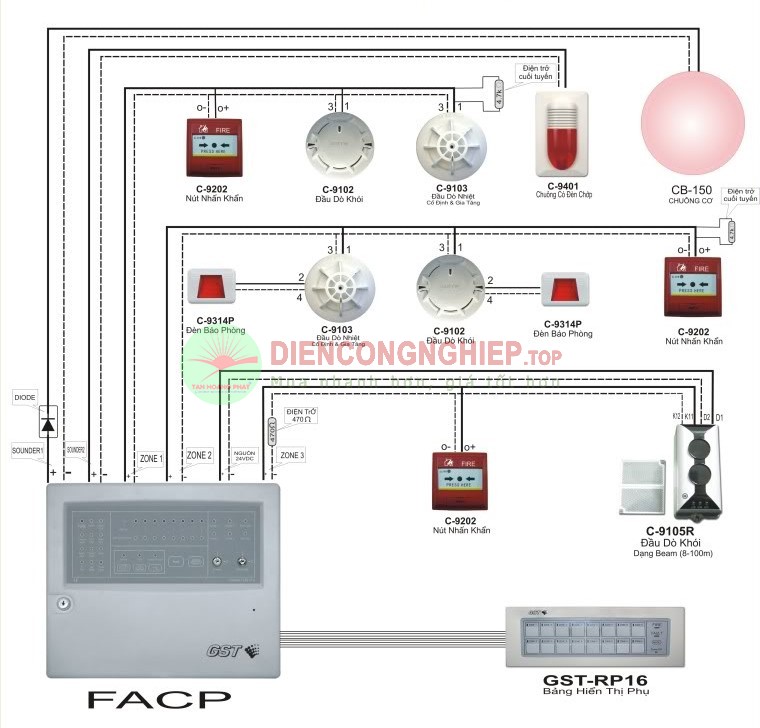
Principle diagram of common fire alarm system
Addressable fire alarm system (Loop)
The components of an addressable fire alarm system include:
Addressable smoke detector, addressable heat detector, addressable fire detector, Beam smoke detector, addressable fire alarm button, fire alarms, fire alarm lights, addressable central fire alarm cabinets, address modules for conventional detectors, Module for connecting and controlling peripherals, signal wiring and power cord. The construction of an addressable fire alarm system needs to comply with the design process. During installation always adhere to the current regulations on occupational safety.
Note: With high technical features, Fire alarm systems are only used for installation in companies where the premises are large (several tens of thousands m2), is divided into many independent areas, departments in each area are separate from each other. Each device in the system is connected directly to the fire alarm panel to help the center receive fire signals in each area, each location explicitly, exactly. From there the center can identify detailed incident information and is displayed on the auxiliary display board to help supervising staff quickly handle the problem.
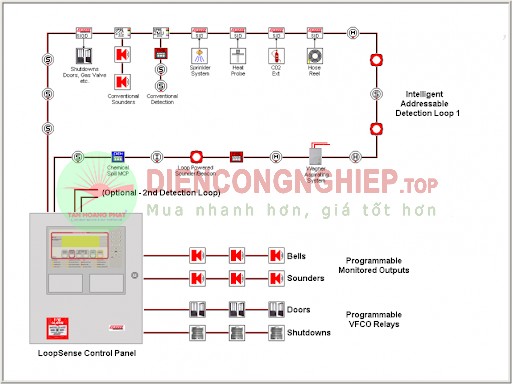
Diagram of addressable fire alarm system
The process of installing fire alarm systems
Step 1: Wiring for all the installation locations of the detector, the bell lights to the location of the fire alarm center.
Step 2: Conduct insulation resistance measurement, continuity measurement for installed wiring.
Step 3: Install equipment (fire detector, light bell, central cabinet of fire alarm …).
Step 4: Carry out a test of the entire system and test the device.
In addition, the wireless addressable fire alarm system applies to projects that: Workshop (under 500m2), high-rise buildings (6-8 floors), hotel, restaurant,… With high stability, easy maintenance.
Common fire extinguishing system:
Fire protection systems walls:
The wall fire fighting system is a non-automatic fire extinguishing system, include: Water pump - check valves, two-way - Pressure reducing valve - Overvoltage protection valve - valve hand - wall fire cabinets - hoses for water (also known as a tornado), When a fire occurs, the firefighters run to the fire cabinets located in or on the wall (The inside contains the plumbing hose that is stacked or rolled up) quickly roll or pull the tube closer to the fire site. then install the spray steering wheel on the wire end, the other end is fitted to the jaws of the water supply valve located in the cabinet, a person holding the tap, the other opens the water supply valve at the cabinet to spray water into the fire.
Operation principle: systems use water for fire fighting including water supply piping system associated with fire pumps, Hose Reel and Fire Hydrant. When a fire incident occurs, The user will put the fire hose spraying water directly into the fire to extinguish.
Installation process:
- Step 1: Install pipes from the pump room to the fire fighting throat boxes
- Step 2: Install a wall fire fighting box.
- Step 3: Install fire pump room.
- Step 4: Test the pressure of the pipe.
- Step 5: Place the sprinkler, fire hose reel in the fire fighting box.
Sprinkler automatic fire protection system:
Sprinkler automatic fire fighting system is one of the most popular fire fighting systems available today.
+ Fire fighting system with water Sprinkler suitable for high-rise buildings, factory, construction…
+ Not suitable for IT server room installations, electrical rooms or products with properties often damaged in water damage.
Advantages: Quick installation, Easy and does not cost much as other specialized fire fighting systems.
The supplies needed for the construction of automatic fire extinguishing system Sprinkler: Sprinkler nozzles, Fire pump system and pipeline, fire valves, Alarm Valve.
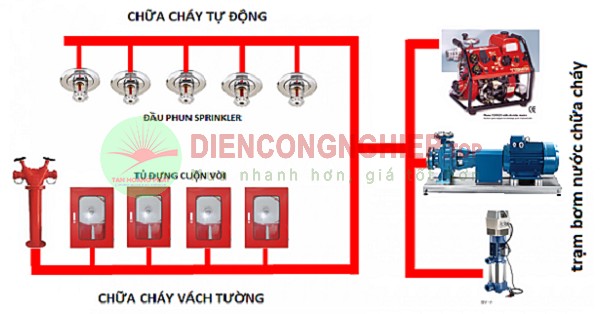
Installation process:
- Step 1: Install the main pipeline from the pump room to the sprinkler branches.
- Step 2: Installation of the first branch speinkler hand.
- Step 3: Test the pressure of the pipeline for the first time.
- Step 4: Install the sprinklers.
- Step 5: Install fire pump room.
- Step 6: Test the pressure of the pipe for the second time.
- Step 7: Test run the fire extinguishing system.
Fire protection system by portable bottle
The common types of fire extinguishers in the building include 2 main types of BC powder portable fire extinguishers, ABC or CO2 portable fire extinguisher.
Powder extinguisher BC, ABC: This is a portable fire extinguisher. Fire extinguishing agent is a type of ABC or BC synthetic powder that is able to effectively extinguish solid fires, liquid and gaseous
CO2 fire extinguisher: CO2 is a product of combustion. It does not sustain combustion. When CO2 is injected into the fire it will prevent the fire's exposure to oxygen. at the same time, CO2 has another important effect, which is to capture the heat of the fire
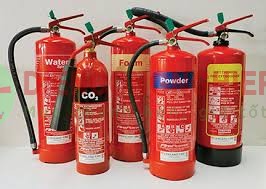
Portable fire extinguisher
Fire protection system with foam Foam
HFoam fire fighting system is a non-automatic fire extinguishing system, including: Foam tanks, pipeline system, Foam nozzles, fire valves, alarm system when there is a fire.
Foam fire extinguishing systems are mainly installed for petroleum and chemical storage.
Foam fire extinguishing systems are now used quite a lot because it reduces the amount of water needed, reduce the amount of fire extinguishing agent when extinguishing the fire, reducing environmental pollution, for high expansion foam, there was almost no damage to the goods and for a short time, the whole warehouse is back to normal.
Foam extinguishing systems are used in places where there is a high risk of fire and explosion, be chosen carefully, required to be equipped with a concentrated foam agent, foam mixing system, foam spray equipment and effective coordination between these components in a fire extinguishing system.
Foam extinguishing system when activated, will spray a foam covering on the surface of the burning area, separate flammable liquid from air and fire, Thanks to that the fire was extinguished.
Foam mixing system can be type “balanced pressure” or “inline”.
The foam nozzle can be the sprinkler head, spray, nozzle, monitor, foam pourer, or high expantion foam generator, depends on the foam system used.
The principle of fire fighting depends on the type of foam that can be extinguished in many ways:
Or is used foam to foam covering the surface on fire a thick foam layer, extinguish the flame and isolate the fuel from continued contact with the air, or cool the fuel with the amount of water contained in the foam, or the government does not cover liquid (fuel) evaporates and blends into the air.

Installation process:
- Step 1: Install the main pipe, branch duct and foam auxiliary ends.
- Step 2: Install the foam tank, foam starter and valve system.
- Step 3: Test the pressure of the pipe.
- Step 4: Connect to automatic fire fighting system or install pump room.
- Step 5: Install alarm system and control system
- Step 6: Test run the fire extinguishing system.
Fire protection system by gas (FM-200, CO2):
Characteristics: FM200 is clean air, safe for the environment and people, high safety standards. Fire fighting system FM-200 is used for areas requiring high safety such as: Pserver room, treasury store, laboratory…
CO2 is a colorless gas, odourless, non-conductive and is highly effective fire extinguishing agent. Automatic fire extinguishing systems using CO2 is used wisely, reliably and quickly control the fire before causing damage to property. CO2 properties are spread very quickly, Should effective firefighting capability. Fire extinguishing systems with CO2 are installed mainly in electrical rooms, generator room ...
The order of activating fire when a fire occurs:
* The smoke / heat sensor activates the fire alarm signal
* Control cabinet receives fire alarm signals transmitted from the detector
* Control cabinet transmits fire alarms emitting bell / horn / lamp, at the same time activate the gas fire extinguisher valve opening
*The fire alarm activates the ringing, The air discharge indicator lights up
* Fire extinguishing gas FM-200 or CO2 is sprayed from the gas tank, according to the gas pipeline, then spray and spread through the gas nozzles installed in the fire area.
* The fire will be put out
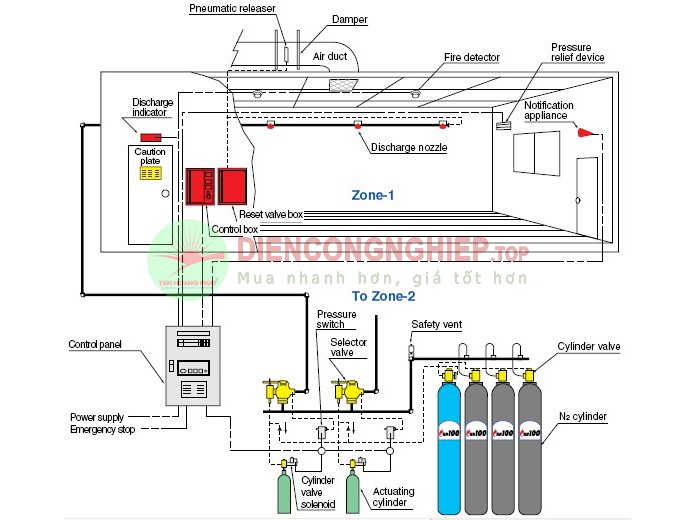
Installation process:
– Step 1: Install main pipes, branch pipes and air auxiliary pipes.
– Step 3: Test the pipe pressure.
– Step 4: Install alarm system and control air discharge
– Step 5: Test the fire extinguishing system.
Emergency lighting system
Incident lighting system consists of 2 main types of lights are emergency lights and exit lights (Exit). This is one of the product lines manufactured under compulsory standards of fire protection systems.
The light is used for the purpose of lighting and guiding the escape when an incident occurs.
The uses of the emergency lighting systems are: Help limit, overcome and minimize the damage that occurs when something goes wrong in the project.
Installation process:
- Step 1: Installation of piping and wiring genetic resources.
- Step 2: Installation of lighting to emergency and exit lights rotten instructions.
- Step 3: Test the system.
Fume extraction system:
Smoke exhaust systems in buildings include: Smoke exhaust booster fans (Centrifugal fans or axial fans) for smoke extraction, Pipeline winds often made of corrugated, suction mouths, of wind emissions, fire stop valves, motor control valve, The sensor, control and power supply cabinets.
Operation principle of incident smoke extraction system: Is when a fire happened, Smoke and heat will be generated at the start of the fire. Temperature sensor system, the smoke sensor of the fire protection system will transmit the signal to the control cabinet for the smoke suction booster fan, immediately the blower will be active. The duct system will transfer all of the smoke through the inlets to the fan and be discharged into the environment through the exhaust outlets. At the same time the bell system, At the same time the bell system, fire alarm lights of the fire protection system works to warn people operating in the buildings to evacuate into the corridor to run to the emergency exits.
When the fire grew bigger, generating high temperatures will affect the fire stop valve causing the fuse in the valve to melt and the fire valve to close shut to prevent the fire from spreading, floors or other areas of the building.
Installation process:
– Step 1: Installation of the wind pipe with respect.
– Step 2: Install the air intakes.
– Step 3: Install a smoke exhaust fan
– Step 4: Install the fan control cabinet and use the power cable for the fan.
– Step 5: Test the system.
The construction of fire protection systems for works is an urgent matter according to the provisions of law.
Construction of a fire protection system not only ensures life safety for yourself and the community, but also creates safety trust for construction works.
CONTACT OFFICE
Tan Hoang Phat Design and Construction Investment Company Limited
Address: 5th Floor, Central Point 219 Trung Kinh, Yen Hoa Cau Giay, Hanoi City
Website: http://diencongnghiep.top
Email: diencongnghiep.top@gmail.com
Facebook: https://www.facebook.com/congtytanhoangphat
Hotline: 0911.066.518, 0969.002.382



